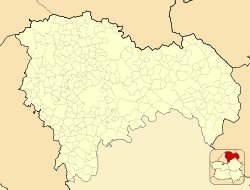Zaorejas, Spain | |
|---|---|
 | |
| Coordinates: 40°45′44″N2°12′4″W / 40.76222°N 2.20111°W [1] | |
| Country | |
| Autonomous community | Castile-La Mancha |
| Province | Guadalajara |
| Municipality | Zaorejas |
| Area | |
• Total | 189 km2 (73 sq mi) |
| Elevation | 1,225 m (4,019 ft) |
| Population (2024-01-01) [2] | |
• Total | 115 |
| • Density | 0.608/km2 (1.58/sq mi) |
| Time zone | UTC+1 (CET) |
| • Summer (DST) | UTC+2 (CEST) |
Zaorejas is a municipality located in the province of Guadalajara, Castile-La Mancha, Spain. According to the 2004 census (INE), the municipality had a population of 197 inhabitants.
There are remains of a Roman aqueduct in the village.
Two other settlements, Huertapelayo and Villar de Cobeta, are part of the municipality.



